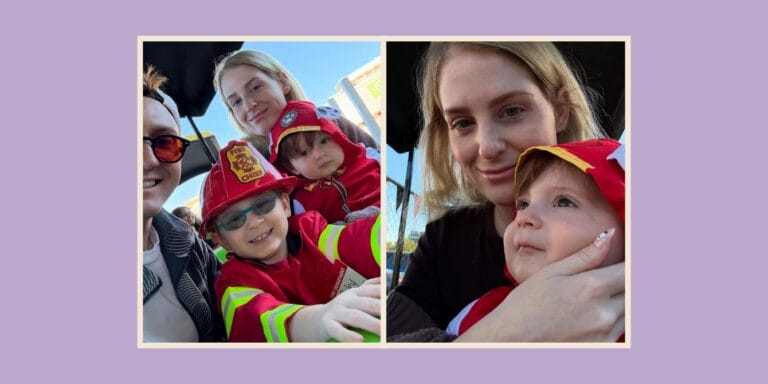When can you sleep train a baby? There’s only one hard-and-fast rule, according to experts

A baby sleep consultant breaks down how old your baby should be before starting.
Table of Contents
With a new baby, it can feel like all you’re thinking about is sleep—usually what you’re not getting. In the first few months of life, babies have their days and nights mixed up, so sleep tends to be disorganized and unpredictable. And while this is developmentally normal for infants, this is part of the reason that many new parents experience sleep deprivation on some level in the newborn stage.
Thankfully though, this is a passing phase, and you’ll find that your baby’s sleep will start to follow a more consistent pattern and rhythm as they graduate from this period. Some babies naturally start to take longer naps and sleep through the night, but the majority of babies require some level of sleep training, or “teaching,” as I like to call it.
Sleep training is a concept that helps teach babies how to sleep independently so that you, as their parent, don’t need to be a part of the equation every time they rouse from sleep during naps or throughout the night (sounds nice, right?). Despite what most people think, it’s completely normal for babies—and actually all of us—to partially rouse throughout the night. However, the challenge comes in when babies are unable to put themselves back to sleep because they lack the skills to do so.
This is where sleep training comes in. If the concept is new to you, you likely have lots of questions—starting with when you can start!
When can I start sleep training with my baby?
When it comes to sleep training, I recommend waiting until your baby is between four to five months old before you start officially sleep training/teaching. Prior to four to five months of age, your baby may not developmentally be ready to start learning to self-soothe, and many parents find that when they start the process too soon, it causes a lot of stress for both the baby and the parents. Around 4 months or so, your baby’s circadian rhythm has kicked in, melatonin production has started, and your baby’s sleep naturally becomes more organized, which helps promote your baby’s internal sleep clock and will make the sleep training process much more realistic and effective.
Of course, there isn’t one magic age at which your baby will be ready for sleep training. Some parents have success at six months or even nine months.
But there are two other ways you can determine that your child is ready for some level of sleep training.
1. You’re ready and have time to commit to the process. I find that many parents dive headfirst into sleep training only to realize that they aren’t ready themselves to commit and stay consistent, which is crucial when sleep training. If you have any big upcoming changes, such as a move, the arrival of a new baby, increased workload, etc., it may not be the right time for your family to focus on sleep training. In order to see progress with your baby, this process requires a level of commitment and consistency. And while you don’t have to be home-bound during the process, you should ensure that you have the time and energy to stay the course.
2. You have laid a healthy foundation of sleep with your baby. Many exhausted parents are eager to jump right into sleep training once their child reaches a certain age—and I get it! However, sleep training requires some prep work to ensure your child is ready to learn independent skills. Without first establishing healthy habits with your baby, sleep training is typically ineffective or may not withstand future regressions and/or developmental leaps.
For example, if your child is chronically overtired because their awake windows (the time period in which they are awake) are too long, trying to teach them how to self-soothe is going to be near impossible—and will likely involve a lot of crying.
Focusing on the key areas of healthy sleep with your infant will better prepare them and ensure the process with your baby is much smoother.
The four areas you want to focus on when laying healthy foundations with your baby are:
- Sleep environment: You want to ensure that your child’s sleep environment is sleep-promoting by keeping the room as dark as possible for all naps and night sleep, using white noise, keeping the room between 68-72 degrees Fahrenheit, and ensuring that for naps and night sleep they are consistently in their own crib or bassinet.
- Nutrition: Whether your baby is breastfed or formula-fed, the goal is for your baby to take in full feeds (approx. 4.5 to 6.5 ounces) every three hours during the day, and one to two feeds at night if needed, and depending on age. If your baby is already on solids when you start the process, that’s fine too, as long as milk still takes priority.
- Routine: Following a nap and nightly routine with your baby is key in promoting healthy sleep as it helps them make positive associations and become familiar with what’s coming next. Your routine will likely range between 15 to 20 minutes prior to their nap and 20 to 30 minutes before bedtime, and can be anywhere from three to six simple steps to prepare your baby for rest. Try adding in books, songs and plenty of snuggling.
- Awake windows: Following age-appropriate awake windows is incredibly important when working on your baby’s sleep, as they can easily become overtired when they aren’t put down at the appropriate time for their age range. (It’s helpful to learn the awake window recommendations by age.)
What if my baby is older—is it too late to sleep train?
You might be worried that you “missed the age cutoff” with your baby, but the truth is, it’s never too late to sleep train your child and implement healthy sleep habits. You just want to keep in mind that the older your baby gets, the longer it’s going to take.
Teaching a five-month-old baby how to self-soothe is a very different process than teaching your 18-month-old toddler. And while it certainly can be done, there will be other things to consider at this stage, such as mobility, behavioral factors, and prolonged habits that have been in place for a while.
How do I sleep train?
Once you are confident that it’s time to start the sleep training process, you’ll likely want to do some research to determine the right approach for your child.
There are many different methods to try—from gentle sleep training to cry-it-out—and plenty in between. I encourage you to focus on what you think is most realistic for your family and not to compare your baby to anyone else’s child or experience.
All babies are different, and each child will require a slightly different approach, so it’s important that you consider your little one’s unique traits and base your sleep training approach on that.
Determining your child’s sleep profile is one way you can figure out the best approach to take with your child during the sleep training process.
Seek additional support if you need it.
Sleep training may seem like a daunting process, but it doesn’t have to be! As long as you wait until the right time, focus on implementing healthy habits first, follow the approach that’s right for your baby and stay committed and consistent, you’ll see progress—and all of you will start getting the rest you truly need.





































